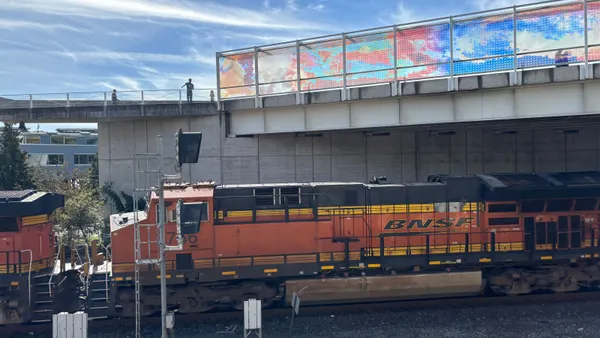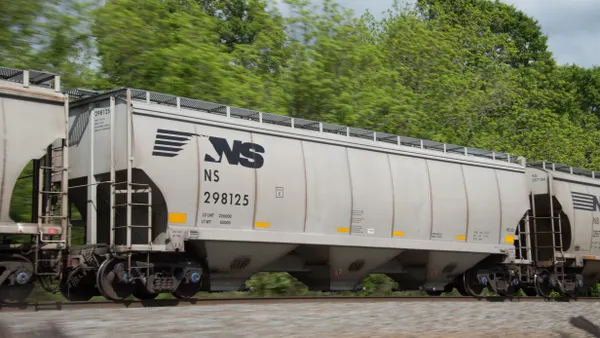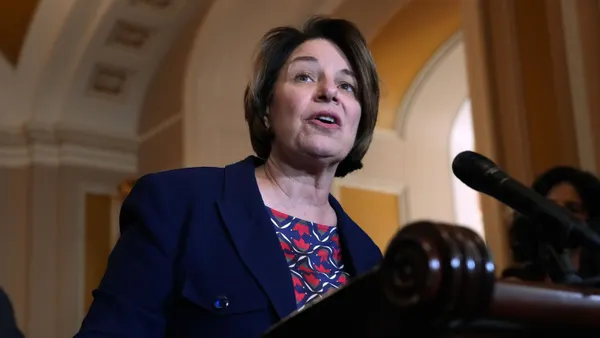Dive Brief:
- BNSF is working to build a third mainline through Kansas this year as part of its multi-year effort to expand its Southern Transcon route, CEO Katie Farmer said during the Midwestern Association of Rail Shippers winter meeting on Wednesday.
- A third mainline through the state will provide more capacity, which will help to improve redundancy and consistency within the network, Farmer said. BNSF announced its capital investment plans Wednesday, including $400 million in "expansion and efficiency projects," which includes the work in Kansas.
- Redundancy is important for the railroad as it works to measure itself in "minutes and not hours — particularly in our intermodal network," Farmer said. "What that means is that, when we have service interruptions between Kansas City and Chicago, we need the ability to very quickly be able to have redundant routes and be able to recover from the service interruption."
Dive Insight:
Farmer's comments come at a time when railroads are increasingly attempting to position their intermodal services as competitive to truck services. And to compete in this area, speed and reliability are a necessity. But the plan to add redundancy contrasts with other railroads that see whittling away at network assets as the more in-vogue option.
Kansas City Southern was one railroad to talk about the need to improve trip plan compliance last year to grow its cross-border intermodal business. And a recent advertisement from BNSF showcases its intermodal service as a more convenient alternative to trucks when shipping to Mexico.
In an era of precision-scheduled railroading, the build-out of excess capacity to improve network flow doesn't exactly jive with the singular obsession with operating ratio. When it comes to network assets such as hump yards and other infrastructure, BNSF has separated itself from the pack. Adherents to PSR are more likely to announce plans to cut hump yards than build out their network. Among the Class I railroads, BNSF is the only one that has passed on many of the main principles of PSR.
And these cuts don't help if the goal is building a more flexible network that can handle disruptions, according to GATX COO Paul Titterton.
"A concern that we hear our shipper customers articulate is that one of the things PSR appears to do is reduce resiliency and redundancy in the industry," Titterton said Wednesday at the MARS conference. "Again, I'm not going to argue positive or negative on things like the closure of hump yards. But what I will say is that as capacity is taken out to move and switch cars, there is a risk that the industry will have less resiliency when a crisis emerges."
If shippers are concerned enough about this loss of resiliency, and think it will impact service, then it could lead to railroads experiencing a loss in load share, Titterton said.
Without redundancy, a rail network can face disruptions that slow down shipments. This is an issue that BNSF faced in 2019 when floodwaters covered its tracks in parts of the Midwest. Union Pacific and Norfolk Southern also dealt with track damage during the storms and had to clear trees and other debris before assessing the state of the tracks. Another mainline means more options when outages like this occur.
BNSF's work to build out its Transcon route began before the 2019 floods. The railroad spent $1 billion on network expansions on the line in 2018, citing similar needs for additional capacity. The work included a new mainline in Amarillo, Texas, that the railroad said will allow for more volume to flow through.
The only privately held U.S. Class I railroad hasn't shown much interest in the PSR model in recent years, with analysts saying it doesn't necessarily make sense for BNSF. As it is investing in a new mainline in Kansas, it is also building logistics centers to serve bulk, merchandise and intermodal segments.
"BNSF has made a good case how they already run to schedules in many cases, and PSR doesn't apply to them a huge percentage the time," Tony Hatch, an independent rail analyst, told Supply Chain Dive last year.














